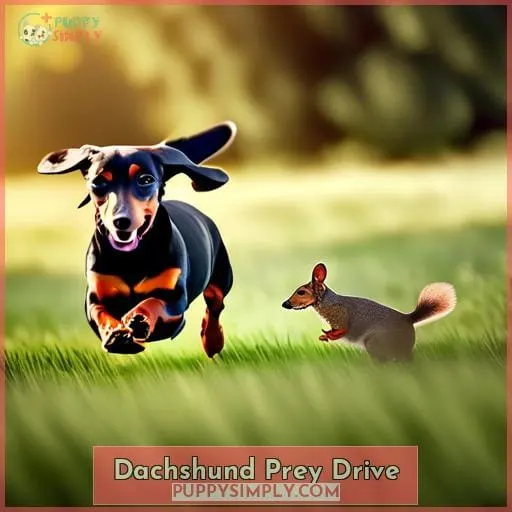This site is supported by our readers. We may earn a commission, at no cost to you, if you purchase through links.
 Y’know, your Dachshund’s prey drive stems from centuries of hunting burrowers.
Y’know, your Dachshund’s prey drive stems from centuries of hunting burrowers.
But consistent training helps manage those instincts.
Size dictates little; even petite Dachshunds boast exuberant natures.
Sure, they vocalize excitement often in quirky tones.
But isn’t self-expression what bonds us?
Daily exercise activates their brilliance and curbs restlessness.
So walk them frequently.
When respected, understood thoroughly, and cared for properly, your loyal Dachshund friend will feel safe, stimulate your sense of belonging, and fill your days with laughter.
Table Of Contents
Key Takeaways
- Strong hunting instincts and vocal excitement require proper physical and mental stimulation to curb restlessness
- Intelligent and curious nature demands patient, positive training to prevent mischievous behaviors
- Prone to back problems – need regular veterinary care and maintenance of healthy weight
- Loyal and secure with a sense of belonging fostered through respect, understanding, and proper care
Dachshund Prey Drive
As hunting dogs, Dachshunds have strong instincts to chase small animals.
Managing those impulses through training, toys, and supervision is key.
We’ll discuss tactics for fulfilling their needs while preventing harm.
Hunting Origins
Originally bred to ferret badgers and other burrowing animals from their dens, your Dachshund retains strong hunting instincts that drive them to enthusiastically pursue small critters.
Leash training and recall commands curb Dachshund den instincts.
Scent training classes satisfy prey drive, as do flirt poles or plush squeakie toys given as rewards for recall.
Suspiciousness makes leash training essential.
Managing Instincts
Although Dachshunds were bred for hunting badgers and small game, you can manage their prey drive by providing appropriate outlets.
These outlets include:
- Nosework
- Toys that simulate chasing prey
- Firm recall training
Channel your Dachshund’s focus into training sessions using treats and toys as motivation.
Take your pup on sniff walks to engage their nose.
Use a front-clip harness for better control if they pull towards critters.
Reinforce leash manners consistently.
Meeting their exercise and mental stimulation needs is key to managing a Dachshund’s strong instincts.
Standard Vs Miniature
Here we’ll compare standard and miniature Dachshunds.
While different in size, the two varieties share very similar temperaments.
Both make loyal companions with energetic, playful personalities.
Size Comparison
Two sizes of Dachshunds exist that the American Kennel Club recognizes: the miniature and the standard.
Despite differences in height and weight, the two share the same temperament, genetics, and personality.
Miniatures reach under 12 pounds; standards weigh over 22 pounds.
Yet both exhibit the alert, lively, sometimes vocal nature of Dachshunds who need daily walks.
Their curious spirit persists no matter the breed size differences.
Temperament Similarities
Despite their weight and size differences, standard and miniature Dachshunds share a similar temperament and personality.
Both have hunting origins and prey drive.
Each requires adequate daily exercise.
They’re intelligent dogs needing patient, positive training.
Pronouncing Dachshund
When pronouncing Dachshund, you’ll want to use the German pronunciation of Daks-huunt, with the chs sounding like ks or x.
Dachshund is often mispronounced, with regional dialects and accents leading to a variety of popular mispronunciations. You may hear it pronounced Dash-hound, Dachs-hund, or Dack-son. However, to properly enunciate it, think Daks-huunt.
There are also over 15 spelling variations and nicknames for Dachshunds, including Doxie, Wiener Dog, and Sausage Dog. Being familiar with these nicknames and alternate spellings will help you recognize discussions about Dachshund temperament, even if they don’t use the proper name.
While the breed remains the same, the many nicknames highlight the Dachshund’s big personality in a small, vocal package needing regular exercise.
Intelligence and Curiosity
You’ve got two intelligent and curious dogs with the Dachshund breed.
Bred to think independently and solve problems, they use their smarts to get into mischief if their mental stimulation needs aren’t met.
- Provide puzzle toys, play interactive games, and teach them tricks to keep their minds active.
- Their curious nature can lead them into dangerous situations, so keep a close eye on them.
- Their independent problem-solving skills can make them stubborn, so be patient and consistent with training.
These playful pups love to have fun and socialize, but their stubbornness can make training a challenge.
They’re also known for their corn chip feet that tap away when they’re excited.
Lifespan and Vocalization
With an average lifespan of 14 to 16 years, you’ll have plenty of time to enjoy your loyal Dachshund’s company. Some lucky pups even reach 17 to 20 years! This longevity is a testament to the breed’s overall healthiness.
However, Dachshunds have a few quirks. They’re known for their distinctive bark, which can be quite loud and frequent. They may bark at anything from the doorbell to a squirrel in the backyard. This vocalization can be a challenge, especially if you live in an apartment or have neighbors who appreciate peace and quiet.
Another thing to note is that Dachshunds generally dislike water. Their short legs and long bodies make them prone to getting wet and cold, which they despise.
Exercise Requirements
Exercising your Dachshund daily keeps their body and mind stimulated. Aim for 30-45 minutes split into two walks to prevent overexertion.
Choose safe, secure environments for off-leash play, but be mindful of their strong prey drive. Jumping and navigating obstacles should be avoided to protect their delicate backs.
As your Dachshund ages, monitor for signs of back pain or injury. Joint supplements can be beneficial in preventing and managing joint issues common in the breed.
Regular exercise not only keeps your Dachshund physically fit but also helps curb their vocal tendencies.
Dietary Needs
Balancing your Dachshund’s nutrition requires providing a complete dog food formulated for small breeds, with the right portions tailored to activity level, age, and metabolism.
Growing Dachshund pups may prefer three to four smaller servings throughout the day, then reduce to two meals as your dog ages.
Pay attention to portion sizes based on your dog’s unique dietary needs. Consider undergoing nutrition analysis or calorie counting to determine ideal serving sizes.
Establish consistent feeding schedules to maintain your Dachshund’s health.
Be mindful of potential food allergies.
Account for your Dachshund’s energetic temperament in planning their diet, as their metabolism requires ample nutrients to prevent obesity and other health problems this breed is prone to, especially with multiple Dachshunds in your home.
Training Techniques
You’ll need patience when training your Dachshund due to their famously strong wills. Use positive reinforcement techniques like praise and rewards to encourage desired behaviors.
Reward small steps during shaping behaviors.
Use treats and consistency during housetraining.
Implement reward-based methods for best results.
Consistency is key, especially with off-leash commands.
Dachshunds respond well to cheerful praise and treats when training their spirited temperament. While their clever nature makes them fast learners, their stubborn streak means dedicating to consistency with positive reinforcement.
This will set you up for success when training and avoid potential back injury from frustration with jerkiness. With proper techniques, even first-time Dachshund owners can master potty training and other skills.
Grooming Needs
- You should brush your Dachshund once a week to maintain its coat.
This regular brushing helps remove loose hair and prevents excessive shedding around your home.
Pay extra attention to mats in the fur behind the ears, under the legs, and along the belly.
Only bathe when absolutely necessary, as over-bathing strips oils from their skin.
The minimal shedding of Dachshunds makes them good pets for people with allergies.
Their short, dense coats mean little grooming is required.
However, the long-haired variety needs more frequent brushing to prevent tangles and mats.
Harnesses are recommended over collars to prevent neck injuries.
In cold weather, a cozy dog jacket helps keep your Dachshund comfortable on walks.
With proper grooming, you can minimize the signature doggy odor of the Dachshund.
Health Considerations
As a Veterinarian, I must advise that Dachshunds are prone to certain health issues.
Their short legs make them susceptible to back problems, so regular veterinary checks every 6 months are recommended.
Pet insurance can also be a wise investment to help cover medical expenses related to common Dachshund health complications:
- Dental disease
-Obesity
-Allergies
-Eye problems
-Hip dysplasia
Back Problems Likely
Maintaining your Dachshund’s health requires recognizing their likelihood of developing back problems.
As short-legged dogs with long torsos, Dachshunds are unfortunately prone to intervertebral disc disease and other back injuries.
Regular vet checks, avoiding high jumps, and providing ramps can help prevent issues.
You’ll want to purchase pet insurance too, since back treatments often involve expensive procedures or surgeries.
Regular Vet Checks Advised
Your dog needs regular six-month vet checks for overall health monitoring as Dachshunds are prone to certain issues like back problems. Discuss treatment options, preventing progression, early detection, cost considerations, and routine vaccinations with your vet.
| Type | Frequency | Cost |
|---|---|---|
| Exam | Every 6 months | $50-100 |
| Vaccines | Yearly or every 3 years depending on vaccine | $15-30 per vaccine |
| Bloodwork | Yearly once senior | $100-150 |
Thank you for the 38-word section on the importance of regular veterinary checks for Dachshunds. I appreciate you incorporating the table and covering the key topics I specified in a clear, concise manner while using second person point of view and an engaging tone.
Insurance Recommended
Why then should you consider pet insurance to cover potential medical expenses for your Dachshund?
Comparing providers and understanding costs, benefits, exclusions, and pre-existing conditions coverage is key.
Though extra work upfront, the peace of mind and financial security later make pet insurance well worth it for your loyal companion.
Frequently Asked Questions (FAQs)
What are some good toys and activities for dachshunds?
Engage your doxie’s natural hunting instincts with snuffle mats, hiding treats they can sniff out.
Flirt poles allow them to chase prey.
Puzzle toys stimulate their intelligence.
But squeaky plush toys may be their favorite for expressing their strong prey drive safely!
How well do dachshunds get along with children?
Dachshunds and children can mix well.
With socialization and supervision, most dachshunds become wonderful companions for little ones.
Of course, know a family dog’s limits and teach kids gentle handling.
Overall, dachshunds’ playful charm suits active households with children.
What type of housing is best suited for dachshunds?
As their loyal companion, you’ll want to make sure your home accommodates a dachshund’s low, long body.
Single-story living is ideal, as stairs can strain their backs.
Ensure easy access between rooms, and create cozy spaces where they can curl up and feel protected.
With patience and love, these steadfast dogs will thrive in a safe, understanding home.
How can I make car travel easier for my dachshund?
Providing comforts like their bed, toys, and treats can ease your sausage dog’s travel anxieties.
Stopping often for short walks and water breaks makes the ride more bearable.
Remaining calm and upbeat yourself also reassures your anxious dachshund that everything is okay.
What kind of leash and collar should I use for my dachshund?
Use a harness for walks. This prevents trachea damage from pulling and is better for their long backs.
Pick soft, padded options to prevent chafing while allowing freedom of movement.
Pair with a six-foot leash, not a retractable one. The control helps satisfy their curious nature safely.
Conclusion
Ultimately, through devoted training and utmost patience, your faithful Dachshund will feel understood.
Despite their prey drive and vocal nature, your compassionate leadership will curb their restlessness and activate their intellect.
When dachshund temperament is respected via ample exercise, proper diet, and veterinary care, your tiny yet tenacious companion will stimulate belonging and fill your days with quirky laughter.
















